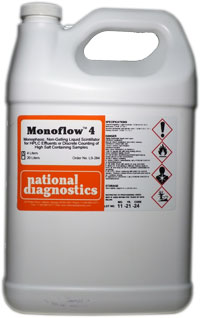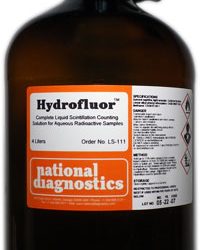Liquid Scintillation
Monoflow 4
$235.00 – $948.00
Quantity discount when you buy 4 or more 4 liter bottles
Hazardous Shipping Fees: This product may incur an additional hazardous shipping fee. We will pack the products to minimize all shipping costs, and the final charge will reflect the shipping cost and any applicable hazardous fees charged by FedEx.
Catalog Number: LS-284
- HPLC Flow Detection of High Salt Samples
Description
Quantity discount when you buy 4 or more 4 liter bottles!
Hazardous Shipping Fees: This product may incur an additional hazardous shipping fee. We will pack the products to minimize all shipping costs, and the final charge will reflect the shipping cost and any applicable hazardous fees charged by FedEx.
Catalog Number: LS-284
- HPLC Flow Detection of High Salt Samples
Monoflow 4 is a liquid scintillation solution for HPLC effluents containing high salt concentrations. Monoflow 4 is especially suited to accommodate ammonium phosphate gradients from 0-2M, at a flow ratio of 3:1 scintillator to sample. Monoflow 4 may also be used for discrete counting of highly polar samples in liquid scintillation vials.
| Lipids/CH3CN | CH3CN:H2O 50:50 | CH3OH:H2O 50:50 | 2M Ammonium Formate |
|---|---|---|---|
| 45 | 43 | 45 | 43 |
Additional information
| Weight | 9 lbs |
|---|---|
| Dimensions | 15 × 10 × 13 in |
Safety Overview
Safety Summary (see SDS for complete information before using product):
Appearance and odor:
Clear liquid with blue phosphorescence and mild odor
Flammable. Harmful if swallowed.
Keep out of reach of children. Do not breathe fumes. Avoid contact with the skin. If swallowed, do not induce vomiting. Seek medical advice immediately and show this container or label.
EMERGENCY OVERVIEW – IMMEDIATE HAZARD
POISON! DANGER! UNDILUTED COMPONENTS CAUSE BURNS TO ANY AREA OF CONTACT. MAY BE FATAL IF SWALLOWED. HARMFUL IF INHALED. CONTACT WITH OTHER MATERIALS MAY CAUSE FIRE.
- Waste Disposal Issues in Scintillation Counting
- The Complete Scintillation Cocktail
- Radioactive Emissions and the Use of Isotopes in Research
- Preparing Tissue Samples for Scintillation Counting
- Preparing Samples in PAGE Gels for LSC
- Mechanism of Liquid Scintillation Counting
- Measurement of Radiation and Isotope Quantitation
- Liquid Scintillation Signal Interpretation
- Liquid Scintillation and Radiation Safety
- HPLC Flow Counting
- Counting Samples on Cellulose-Ester Filters
- Counting Samples from TLC Plates by LSC
- Counting Efficiency and Quenching
- Counting Carbon Dioxide by LSC
- Chemiluminescence and Static Electricity
- Assaying Discrete Samples by Liquid Scintillation Counting



